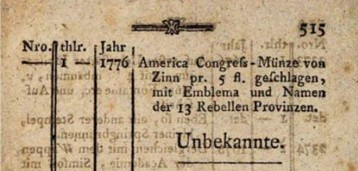
PREV ARTICLE
NEXT ARTICLE
FULL ISSUE
PREV FULL ISSUE
MORE ON THE 1785 CONTINENTAL DOLLAR SALELast week Julia Casey described some early mentions of U.S. colonial paper money and a Continental Dollar coin in German publications. She asked for reader assistance with translation. -Editor 
Ralf Böpple writes: "With regard to the listing of the Continental dollar, the Google translation is correct, unfortunately I have no clue what "pr. 5 fl." could refer to. "fl." of course is usually the abbreviation of Gulden, but this makes little sense here. Maybe it's a description, known to the contemporary readers, stating that the coin is not made of pure tin, but an alloy (i.e., pewter)?" Martin Purdy of New Zealand writes: "Here's my best shot at this, though mileage may vary, as they say: Fl is an abbreviation for florin, which was an alternative name for the Gulden, a unit of account in Bavaria. Wikipedia says the gulden was worth 5/12 of a Conventionsthaler from the 1750s to 1837, which covers the date of the catalogue. 5 gulden would thus be 25/12 or just over 2 Conventionsthaler. So I read this as meaning the Continental dollar was struck in tin (could cover other similar alloys, e.g. pewter), with a unit value of 2 thalers. At a pinch it could mean they were struck at a cost of 2 thalers each, but that sounds expensive, plus what would that imply? That they were made in Germany? It probably raises more questions than it answers but hopefully it will add at least something to the story. I also thought "geschlagen" might have doubled as an older variant of "angeschlagen" (estimated), and that 5 fl. was the estimated sale price, but a text search of the whole catalogue doesn't bring up any comparable references, so at this stage I'd rule that out." Peter Jones writes: "In Bavaria the Gulden (also called Florin) was a unit of account according to Wiki. It was worth 60 Kreuzer. 60 Kreuzer or one gulden was 0.276 oz actual silver weight, and 5 gulden or florins were 1.38 ounces actual silver weight. Pr. 5 fl. could mean preis 5 florins (price 5 florins). "This was then around 7 shillings and sixpence. But Sarah Banks' advertisement said only 6 pence (English) each! The period is too far from the 5 to be interpreted as 0.5 florins (around 9 pence English), and I cannot imagine advertising using decimal points in 1785. "I also noted that below the listing was unbekannte which means "unknown". This makes me wonder whether this is really an advert to sell the piece at all, or just a listing." Ralf Böpple adds: "I don't think the "pr. 5 fl." is any indication of a price. The whole description reads "Münze von Zinn pr. 5 fl. geschlagen", which means "Coin coined of 'tin pr. 5 fl.'", which is why I think our unknown abbreviation is referring to a closer specification of the type of tin (or alloy) that was used. Unfortunately, the abbreviation 'pr.' is not used anywhere else in the whole catalog. "The book as a whole is a list of the coins in the collection of one Mr. von Seuffenheld, to be sold in Nuremberg. Apparently, the whole collection was for sale, but no prices and no conditions of the sale are mentioned. There are some coins from Latin America, dutifully listed under Spain, as they were Spanish colonial issues. The only non-European non-Colonial coin is our Continental dollar, listed last in the "miscellaneous" section, right above the very last two entries, which are unknown items ("Unbekannt"). That much about the importance given to this numismatic object in the context of the whole list! "The collection is formed of mostly thaler-sized coins of the 16th-18th century (rather "recent" at the time of the sale, I guess). I would assume that the collector and seller, Mr. von Seufferheld, was a merchant or a well-connected businessman in order to be able to form such a vast and international collection. Given that there is a Spanish Colonial 8 Reales dated as late as 1773 included in the list, I don't think it is beyond any possibility that a Continental dollar of 1776 coming from overseas could have found its way into the von Seufferheld collection as well. It held no monetary value, being made of tin, but it was attractive enough as a curiosity from the New World for a traveller to bring back from a trip to the newly independent United States." Martin adds: "I've had one reply from my translators' group so far, suggesting it means "struck for 5 fl. each", which is linguistically plausible, at least. I don't know the ratio between the Conventionsthaler and US/Spanish dollar at the time, but that sounds like a healthy premium over face. And it does start to sound like they were sold as medals/souvenirs/patterns (in Germany?) at that point." Maureen Levine writes: "Julia's discovery of the Continental Dollar in a 1785 numismatic auction catalog is fascinating! "Also, the inclusion of my name in Dave Bowers' "My Journey" blog article was an error, and I have requested its correction. I have never considered the Continental Dollars to be anything but coinage." Thanks, everyone! Lots to digest. We know one example of the Continental Dollar in tin or pewter made its way to a German collection by 1785. We don't know where it came from. -Editor
To read the earlier E-Sylum articles, see:

Wayne Homren, Editor The Numismatic Bibliomania Society is a non-profit organization promoting numismatic literature. See our web site at coinbooks.org. To submit items for publication in The E-Sylum, write to the Editor at this address: whomren@gmail.com To subscribe go to: https://my.binhost.com/lists/listinfo/esylum All Rights Reserved. NBS Home Page Contact the NBS webmaster 
|